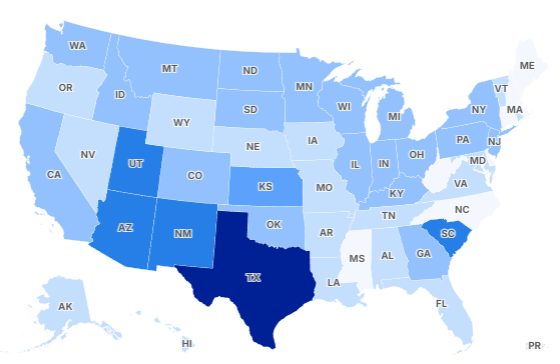The U.S. federal government entered a partial shutdown at 12:01 a.m. EDT on October 1, 2025, after Congress failed to pass a funding resolution to keep operations fully financed into the new fiscal year. As of early November, the shutdown has extended into its fifth week, affecting multiple agencies and programs while leaving thousands of federal employees temporarily unpaid. The continuing stalemate is beginning to ripple across federal operations, public services, and the broader economy.
Legislative Impasse
The shutdown stems from a failure in Congress to approve appropriation bills or a continuing resolution to fund federal agencies. Republicans, who hold the House and Senate majority, advanced a “clean” continuing resolution to fund agencies through November 21. The Senate, however, rejected the measure, leaving the government without full funding.
Democrats have demanded that any funding bill include provisions for continuing certain healthcare subsidies, while Republicans have opposed pairing policy changes with funding measures. This impasse has created a standstill in government operations, marking one of the longest funding gaps in modern U.S. history.
Impact on Federal Employees
The shutdown has directly affected federal employees. Approximately 750,000 federal workers have been furloughed, while others designated as “essential” are working without pay. Furloughed employees are temporarily sent home, while essential staff—such as air traffic controllers, national park rangers, and certain Department of Defense personnel—continue to report to work.
These delays in paychecks have caused financial strain for many families. Federal agencies are preparing for back pay once the shutdown concludes, but employees continue to face uncertainty.
Disruption to Government Services
A number of government services have been disrupted. Federal agencies responsible for key economic data—such as the Bureau of Labor Statistics and the Census Bureau—have suspended portions of data collection. This affects the timely release of reports critical for economic planning and business decision-making.
Air traffic control operations have also been affected. Staffing shortages have led to delays at several major airports. While flights are still operating, passengers have experienced longer wait times and cancellations due to reduced staffing levels in air traffic control towers.
Impact on Social Programs
Social programs that support vulnerable Americans have been directly affected. The Supplemental Nutrition Assistance Program (SNAP), which provides food assistance to millions of low-income Americans, is operating with limited funding. Some states have had to implement emergency measures to continue delivering benefits during the funding gap.
Programs supporting low-income women and children, as well as certain public health initiatives, have also faced interruptions. These disruptions have prompted courts in some states to authorize emergency measures ensuring continued distribution of assistance, highlighting the real-world consequences of extended shutdowns on the public.
White House Statement
In a press briefing, White House Press Secretary Karoline Leavitt addressed the ongoing shutdown. She emphasized that reopening the government is a top priority and highlighted the impact of the shutdown on federal employees and critical programs.
Leavitt noted that the administration is exploring all available legal and procedural options to ensure continuity of essential services. She stressed that while policy negotiations remain important, the immediate focus must be on resuming normal government operations and providing stability to employees and program beneficiaries.
Economic Implications
Economic experts have warned that prolonged government shutdowns can have measurable impacts on the national economy. The Congressional Budget Office estimates that a shutdown lasting six to eight weeks could reduce economic output by billions of dollars. Sectors reliant on government contracts or services, including research, transportation, and healthcare, face delays that could ripple through the broader economy.
Additionally, the suspension of certain federal operations—such as permitting, inspections, and grant distribution—can slow both private sector projects and public initiatives, compounding the economic effect over time.
Legislative and Constitutional Considerations
Beyond immediate impacts, prolonged shutdowns raise strategic and constitutional questions. The U.S. Constitution grants Congress the power of the purse, but funding gaps have increasingly forced the executive branch to use legal and procedural measures to continue certain operations. Analysts caution that relying on executive discretion during extended shutdowns could set precedents that alter the balance of power between Congress and the Presidency.
Lawmakers are weighing various options to resolve the impasse, including short-term continuing resolutions, long-term appropriations bills, and procedural changes in the Senate to overcome legislative gridlock.
Potential Outcomes
Several scenarios are possible as the shutdown continues:
-
Passage of a Continuing Resolution: If Congress passes a funding resolution soon, government operations can resume, furloughed employees will receive back pay, and disruption to public services may be mitigated.
-
Prolonged Shutdown: If negotiations stall further, the disruption could extend into November and beyond, with increasingly severe effects on federal employees, beneficiaries of social programs, and economic performance.
-
Political and Procedural Changes: Both the administration and lawmakers have indicated a willingness to explore procedural options, such as adjusting Senate rules, to prevent future impasses. These moves would require careful consideration due to their potential long-term implications for governance.
Federal Workforce and Public Services
Furloughed employees and those working without pay face personal financial strain, including delayed mortgage payments, bills, and household expenses. Agencies are monitoring staffing levels to ensure essential services—such as air traffic safety, law enforcement, and military operations—remain operational.
Programs providing direct assistance to citizens, such as SNAP and other food programs, face limited funding. States are stepping in with emergency measures where possible, but the uncertainty surrounding funding has caused concern for vulnerable populations who rely on these programs.
Public Perception and Political Pressure
The ongoing shutdown has intensified public attention and political pressure. Polls indicate widespread concern among Americans regarding the disruption to federal services and the potential economic fallout. Lawmakers are navigating a complex environment of public opinion, party priorities, and constitutional responsibilities as they work toward a resolution.
Conclusion
The 2025 federal government shutdown is affecting federal employees, disrupting core government services, and threatening support programs for vulnerable populations. While the administration has emphasized its commitment to reopening the government, Congress must reach agreement to fund operations and restore stability.
The impact of the shutdown extends beyond immediate operational issues, affecting economic indicators, public confidence, and the daily lives of millions of Americans. Timely action by lawmakers remains critical to mitigate both short-term hardships and long-term consequences.
As negotiations continue, the federal government, its workforce, and program beneficiaries await the resolution that will restore funding, reopen services, and ensure continuity in the nation’s essential functions.

Emily Johnson is a critically acclaimed essayist and novelist known for her thought-provoking works centered on feminism, women’s rights, and modern relationships. Born and raised in Portland, Oregon, Emily grew up with a deep love of books, often spending her afternoons at her local library. She went on to study literature and gender studies at UCLA, where she became deeply involved in activism and began publishing essays in campus journals. Her debut essay collection, Voices Unbound, struck a chord with readers nationwide for its fearless exploration of gender dynamics, identity, and the challenges faced by women in contemporary society. Emily later transitioned into fiction, writing novels that balance compelling storytelling with social commentary. Her protagonists are often strong, multidimensional women navigating love, ambition, and the struggles of everyday life, making her a favorite among readers who crave authentic, relatable narratives. Critics praise her ability to merge personal intimacy with universal themes. Off the page, Emily is an advocate for women in publishing, leading workshops that encourage young female writers to embrace their voices. She lives in Seattle with her partner and two rescue cats, where she continues to write, teach, and inspire a new generation of storytellers.









